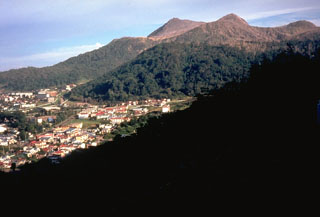Report on Toya (Japan) — December 1977
Natural Science Event Bulletin, vol. 2, no. 12 (December 1977)
Managing Editor: David Squires.
Toya (Japan) Weak steam emission through November
Please cite this report as:
Global Volcanism Program, 1977. Report on Toya (Japan) (Squires, D., ed.). Natural Science Event Bulletin, 2:12. Smithsonian Institution. https://doi.org/10.5479/si.GVP.NSEB197712-285030
Toya
Japan
42.544°N, 140.839°E; summit elev. 733 m
All times are local (unless otherwise noted)
Weak emission of white to grayish-white steam continued through November from small craters and fissures near the summits of Ko-Usu and O-Usu. During November, daily rates of uplift declined slightly at both [peaks of the uplifting block] (Ogari-yama and another centered about 240 m ENE of Ko-Usu's summit) to about 40 cm/day, from October rates of 45 and 60 cm/day respectively. Subsidence of Ko-Usu had also slowed, from 40 cm/day in October to about 30 cm/day in November. According to the Japan Times, a team of Hokkaido University geophysicists has located a shallow ellipsoidal aseismic zone beneath the two cryptodomes. The zone has a maximum dimension of 1 km and a minimum dimension of 0.5 km, but it was not possible to determine its depth from the newspaper article.
Further Reference. Yokoyama, I., 1978, The 1977 eruption of Usu volcano with a special reference to prediction of volcanic activities: Bulletin of the Volcanological Society of Japan, 2nd series, v. 23, no. 1, p. 65-82.
Geological Summary. Usuzan, one of Hokkaido's most well-known volcanoes, is a small stratovolcano located astride the southern topographic rim of the 110,000-year-old Toya caldera. The center of the 10-km-wide, lake-filled caldera contains Nakajima, a group of forested Pleistocene andesitic lava domes. The summit of the basaltic-to-andesitic edifice of Usu is cut by a somma formed about 20-30,000 years ago when collapse of the volcano produced a debris avalanche that reached the sea. Dacitic domes erupted along two NW-SE-trending lines fill and flank the summit caldera. Three of these domes, O-Usu, Ko-Usu and Showashinzan, along with seven crypto-domes, were erupted during historical time. The 1663 eruption of Usu was one of the largest in Hokkaido during historical time. The war-time growth of Showashinzan from 1943-45 was painstakingly documented by the local postmaster, who created the first detailed record of growth of a lava dome.
Information Contacts: Y. Katsui, Hokkaido Univ.; JMA, Tokyo; Japan Times.

